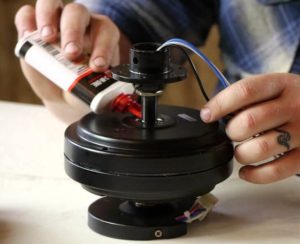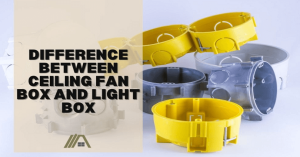The ceiling fan is often misunderstood in the ventilation world, but it actually has the ability to enhance the effects of other devices that regulate indoor air temperature. Instead of canceling out the impact of another device, the ceiling fan can actually work with it.
In the case of a humidifier, for example, a ceiling fan (when spinning in the correct direction) can help in maximizing its effectiveness or mitigating any negative results that may arise from using the humidifier.
The rotation direction of ceiling fans, whether it is clockwise or counterclockwise, plays a significant role in increasing air circulation within a room. This improved airflow helps with the more effective distribution of humidified air. Depending on the season and desired outcome, the heat added by a humidifier can either enhance the performance of the ceiling fan when set to winter mode (clockwise spin) or be counteracted by summer mode (counterclockwise spin).
Should You Use a Ceiling Fan With a Humidifier?
Using a ceiling fan in combination with a humidifier can significantly enhance the humidifier’s effectiveness. The air circulation in the room can be increased by the ceiling fan, resulting in better distribution of moisture.
While certain humidifiers come with small built-in fans to help you in circulating the humidified air, their efficacy is limited to smaller spaces. As a result, some areas within a room might become excessively humidified, while others remain unaffected.
However, when you use both a ceiling fan and a humidifier simultaneously, it promotes uniform dispersal of humidity and allows for a wider range of air movement.
Potential Issue
To effectively benefit the occupants in a room, it is essential to use a humidifier to increase moisture in the air. However, it is essential to use both of them in an enclosed space where the escape of humidified air is minimized.
In situations where the room is not enclosed, such as when there are air leaks, open windows, or internal/external doors left open, the potential for humidified air to escape is significantly higher. Furthermore, the improved air circulation also increases the rate of air loss from the room.
To avoid this issue, it is recommended to take preventive measures. One effective approach is to close the windows and doors, ensuring that the moisture remains confined and evenly distributed within a specific area. Additionally, sealing up gaps and cracks, including the air gaps in baseboards, may be necessary in some cases.
Any Direction for Air Circulation
Ceiling fans offer two modes of rotation: counterclockwise (summer mode) and clockwise (winter mode). Both directions contribute to air movement, making them suitable for enhancing the distribution of humidified air.
In terms of effectiveness, the summer mode (with air blowing downward) generally proves more efficient as it produces higher airflow rates.
However, it’s important to note that this mode can also result in strong air currents directly blowing over you, which may not always be comfortable. This can be especially true during winter or when you’re trying to sleep. To prevent it, you can opt for a slower speed setting.
Clockwise to Take Advantage of Humidifier Heat
Humidifiers operate by heating water and converting it into steam, making them heat-generating devices.
In addition to utilizing a ceiling fan for improved distribution of humidified air, you can also leverage the heat generated by humidifiers to enhance the effectiveness of your fan during the winter season.
During winter mode, which is typically associated with clockwise rotation on a ceiling fan, cold air is drawn upwards away from people, while warm air near the ceiling (where it naturally tends to accumulate) is forced downwards into the occupied area of the room.
While this method may not be highly effective when solely relying on the existing warmth in the room, introducing a heat source significantly enhances its efficiency.
Humidifiers release warm air since warm air carries moisture more effectively than cold air. By setting the fan to winter mode, properly dispersing the humidified air, and taking advantage of the heat it provides, you can also get advantage of the warmth of the released air.
Counterclockwise to Off-Set the Added Heat
Using a humidifier during the summer months can be challenging due to the additional heat it introduces into the room (against the misconception of some people that it can make your fan blow cold air). Furthermore, they impede the process of evaporative cooling, making the room feel warmer overall.
However, if you still want to get the benefits of a humidifier but find yourself becoming uncomfortably warm due to the added heat, you can counteract this by using a ceiling fan in summer mode.
Ceiling fans provide a cooling effect through wind chill by creating air movement around you, rather than directly cooling the air in the room. This is beneficial because if the purpose were to cool the air, it would cause the newly humidified air to lose its moisture through condensation. By utilizing the even distribution of humidified air with the assistance of a ceiling fan, you can enjoy the combined benefits of improved humidity and the cooling effects of the fan’s airflow.
Distance Between Humidifier and Ceiling Fan
The distance between both appliances is an important factor to consider. In a small room, these devices will naturally interact with each other. However, in a larger room, it becomes important to position them close enough to ensure proper interaction and airflow.
If it is not feasible to have the ceiling fan and humidifier in close proximity, it is advisable to set the fan to run counterclockwise. This direction generates greater airflow.


